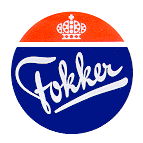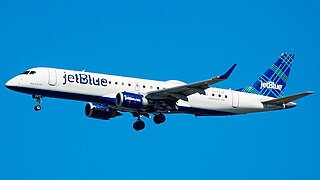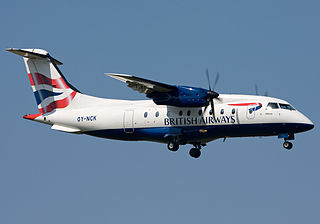
Fokker, was a Dutch aircraft manufacturer that operated from 1912 to 1996. The company was founded by the Dutch aviator Anthony Fokker and became famous during World War I for its fighter aircraft. During its most successful period in the 1920s and 1930s, Fokker dominated the civil aviation market. The company's fortunes declined over the course of the late 20th century. It declared bankruptcy in 1996, and its operations were sold to competitors.

The Yakovlev Yak-40 is a regional jet designed by Yakovlev. The trijet's maiden flight was in 1966, and it was in production from 1967 to 1981. Introduced in September 1968, the Yak-40 has been exported since 1970.
KLM Cityhopper is the regional airline subsidiary of KLM, headquartered in Haarlemmermeer, North Holland, Netherlands. It is based at nearby Amsterdam Airport Schiphol. As a subsidiary of Air France–KLM, it is an affiliate of SkyTeam. The airline operates scheduled European feeder services on behalf of KLM.

The Fokker F27 Friendship is a turboprop airliner developed and manufactured by the Dutch aircraft manufacturer Fokker. It is the most numerous post-war aircraft manufactured in the Netherlands; the F27 was also one of the most successful European airliners of its era.

The Fokker F28 Fellowship is a twin-engined, short-range jet airliner designed and built by Dutch aircraft manufacturer Fokker.

The British Aerospace ATP is an airliner designed and produced by British Aerospace. It was an evolution of the Hawker Siddeley HS 748, a fairly successful feederliner of the 1960s.

The Fokker 100 is a regional jet that was produced by Fokker in the Netherlands. The Fokker 100 was based on the Fokker F28 with a fuselage stretched by 18.8 ft (5.7 m) to seat up to 109 passengers, up from 85. It is powered by two newer Rolls-Royce Tay turbofans, and it has an updated glass cockpit and a wider wing and tail for increased maximum weights.

The Embraer E-Jet family is a series of four-abreast, narrow-body, short- to medium-range, twin-engined jet airliners designed and produced by Brazilian aerospace manufacturer Embraer.
AirUK was a wholly privately owned, independent regional British airline formed in 1980 as a result of a merger involving four rival UK-based regional airlines. British and Commonwealth (B&C)-owned British Island Airways (BIA) and Air Anglia were the two dominant merger partners. The merged entity's corporate headquarters were originally located at Redhill, Surrey, the location of the old BIA head office. It subsequently relocated to Crawley, West Sussex. In addition to the main maintenance base at Norwich Airport, there also used to be a second major maintenance base at Blackpool Airport. This was closed down following Air UK's major retrenchment during Britain's severe recession of the early 1980s. In 1987, Air UK established Air UK Leisure as a charter subsidiary. The following year, Air UK shifted its headquarters to London Stansted Airport. When Stansted's new Norman Foster-designed terminal opened in 1991, the airline became its first and subsequently main tenant.
Air Niugini Limited is the flag carrier of Papua New Guinea, based in Air Niugini House on the site of Port Moresby International Airport, Port Moresby. It operates a domestic network from Port Moresby to 12 major airports while its subsidiary company, Link PNG, operates routes to minor airports. It also operates international services in Asia, Oceania, and Australia on a weekly basis. Its main base is Port Moresby International Airport, which is located in 7 Mile, Port Moresby, Papua New Guinea. Niugini is the Tok Pisin word for New Guinea.

The Fokker 50 is a turboprop-powered airliner manufactured and supported by Dutch aircraft manufacturer Fokker. It was designed as an improved version of the successful Fokker F27 Friendship. The Fokker 60 is a stretched freighter version of the Fokker 50.
Air Ontario Inc. was a Canadian regional airline with its predecessor initially headquartered in Sarnia and later in London, Ontario. In 2002, Air Ontario became Air Canada Jazz.

Time Air was an airline in Canada founded in 1966 by businessman Walter “Stubb” Ross from Lethbridge in Alberta. It was called Lethbridge Air Service before becoming Time Airways Ltd. in 1969, which was later shortened to Time Air Ltd. In 1993 it was merged with Ontario Express to create Canadian Regional Airlines.

The Dornier 328 is a turboprop-powered commuter airliner. Initially produced by Dornier Luftfahrt GmbH, the firm was acquired in 1996 by Fairchild Aircraft. The resulting firm, named Fairchild-Dornier, manufactured the 328 family in Oberpfaffenhofen, Germany, conducted sales from San Antonio, Texas, United States, and supported the product line from both locations. A jet-powered version of the aircraft, the Fairchild Dornier 328JET, was also produced.

A regional jet (RJ) is a jet-powered regional airliner with fewer than 100 seats. The first one was the Sud-Aviation Caravelle in 1959, followed by the widespread Yakovlev Yak-40, Fokker F-28, and BAe 146. The 1990s saw the emergence of the most widespread Canadair Regional Jet and its Embraer Regional Jet counterpart, then the larger Embraer E-Jet and multiple competing projects. In the US, they are limited in size by scope clauses.
Fokker Next Gen NV is a Dutch company dedicated to develop and manufacture a hydrogen-powered regional airliner.

The Fokker F26 was an early jet airliner design created by the Dutch aircraft manufacturer, Fokker.

Piedmont Airlines was an airline in the United States that operated from 1948 to 1989, when it was acquired by and merged into USAir. Its headquarters were at One Piedmont Plaza in Winston-Salem, North Carolina, a building that is now part of Wake Forest University.

Air Anglia was a wholly privately owned, independent British regional airline formed at Norwich Airport in 1970. Created as a result of a merger of three smaller operators, the new entity became an important regional scheduled carrier during the 1970s, serving the Eastern half of Britain. In 1980 Air Anglia merged with three regional rivals to form Air UK.
















